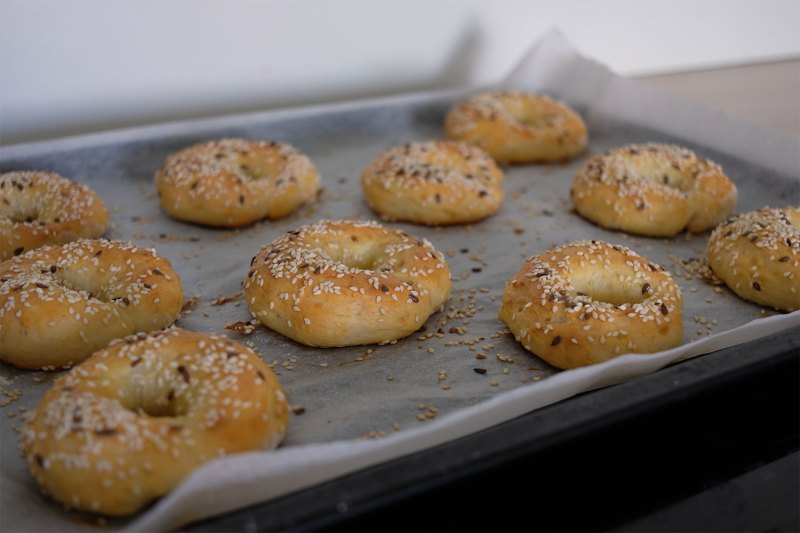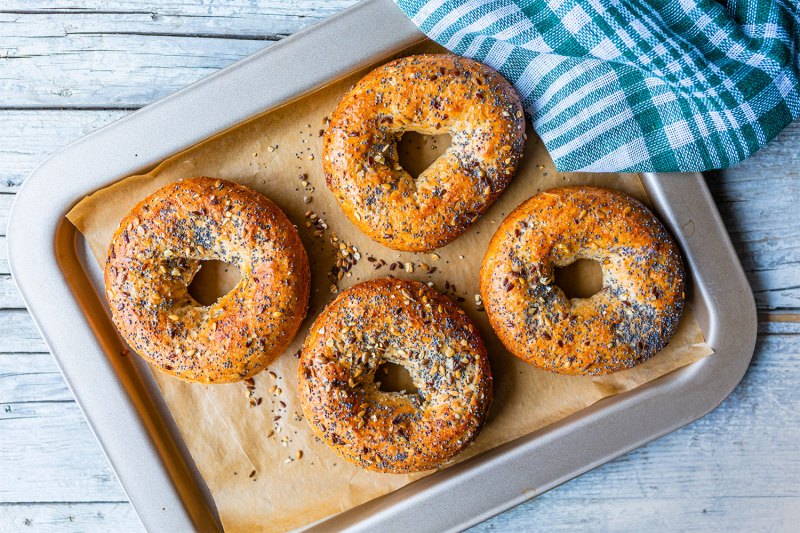Ambitious baking projects became a popular pastime during the pandemic (remember the Age of Sourdough?), with plenty of amateur boulangers whipping up cakes, pastries, and bread products in the comfort of their own kitchens. These quiet times in our social calendars make for ideal opportunities to test out recipes that we never had the bandwidth to attempt before, including laminated croissants, macarons, and even bagels.
As a long-time New Yorker, I’ve never felt the need to make my own bagels; why would I, when the best versions in the world can be purchased at dozens of different local spots? However, as the pandemic stretches on, I find myself considering relocation in the near future (#TheRentIsTooDamnHigh) … and if I end up in a city with a lesser bagel game than that of the Big Apple (so…if I end up in any other city in the world), I’m going to need to know how to prep my favorite start-of-day repast with my own two hands.
Luckily for me, the expert bakers we consulted for this article claim that bagels aren’t quite as challenging to make as I’d always assumed. Read on for their tips on how to make bagels that will bring a nostalgic tear to any former New Yorker’s eye.

The texture of your bagel will depend on the water content in your batter.
Many baking beginners who’ve found themselves defeated by bagels lament the challenge of achieving that perfect bagel texture. This task feels far less mysterious when you discover the level of control that you have over the ultimate toothsomeness of your bagels; according to recipe developer and co-founder Chris Riley of The Daring Kitchen, it’s all about your dough’s moisture level. “For crispier bagels, you need wetter dough. This is a matter of personal preference, so if you would like a chewier bagel, then opt for less hydration,” explains Riley.
Fresh yeast and high-gluten flour need to be at the top of your shopping list
Bagels aren’t especially labor-intensive, but they can be finicky, especially when it comes to specific ingredients. To get the best-possible bagels from your baking adventure, COO (and 6th-generation bagel-maker) Alex Rosner of Bagel Boss in Long Island, New York insists that you first get your hands on “fresh yeast and high-gluten flour; those are two very important aspects of the bagel making process.”
Boiling your bagels is an essential step
When it comes to getting the soft interior and chewy exterior that makes bagels so beloved, the water content plays an important role. But it’s also essential to consider your cooking methods; the oven alone won’t get you that perfect textural contrast. You’ll also need to drop your bagel dough into a pot of boiling water for a quick dip before transferring them to the oven. “The absolute most important tip for making bagels at home is to boil them. Boil for one minute on each side, drain, dip into your favorite topping(s), and bake at 350 degrees for 18 minutes. If you don’t boil them, they’re not bagels, they’re rolls! The distinctive shiny crust and the chewiness inside that makes a bagel a bagel comes from boiling,” insists pastry chef and program coordinator Teresa Shurilla of the University of Hawai’i Maui College Culinary Arts Program.
Bagel-making is a marathon, not a sprint
Well-honed techniques and impeccably sourced ingredients can certainly make a difference to the quality of any baked good…but the most necessary contributor to the success of a baking endeavor is patience. The more “advanced” the project, the more you need to be willing to take your time and avoid shortcuts. That’s unquestionably the case with bagels; pastry chef Carla Tomasko and chef/owner Anne Quatrano of Star Provisions Market & Café in Atlanta, Georgia even encourage bagel-makers to “shape [your dough] and let it slow-proof overnight in the refrigerator for the best result!”
Classic Bagels
(By The Institute of Culinary Education, New York, New York)
If you’re looking for a traditional bagel recipe that provides an excellent canvas for toppings like sesame seeds, poppy seeds, or dried onion flakes, then this version from the Institute of Culinary Education will serve you well. This recipe advises adding malt syrup to the dough and sugar to the boiling water to infuse the finished product with extra flavor. And whatever you do, don’t skip that boiling step; ICE lead chef Tracy Wilk says that “boiling your bagel is what makes a bagel a bagel. At the same time, don’t leave them in the water for too long or they will lose their shape.”
Ingredients:
- 570g water, cold
- 14g malt syrup
- 14g SAF dry yeast
- 795g high-gluten flour
- 115g all-purpose flour
- 14g salt
- Granulated sugar, as needed
- 1 egg white, beaten
- Toppings (sesame seeds, poppy seeds, everything spice mix etc.), as desired
Method:
-
- To make the dough, add water and malt syrup to a mixing bowl. Whisk in the yeast. Add flours and salt on top.
- Mix with on low speed, using the hook attachment of a mixer, for 6 minutes. Transfer the dough onto a lightly floured surface and knead briefly by hand until the dough is smooth.
- Place the dough in an oiled bowl and cover to let it proof for at least an hour.
- Heat a large, wide pot of water. For every gallon of water, add about 3 ounces granulated sugar.
- Preheat oven to 350 degrees Fahrenheit.
- Divide the dough into 13 115-gram (4-ounce) pieces. Make rectangles with the dough, then roll the seam under itself tightly about 1/3 of the way in. Repeat with all 13.
- Once tightly rolled, proceed to roll the logs to about 10 ½ inches with thin edges, like a snake.
- Dab cold water on one end and connect to make a circle. Roll the seam on the table, working it in so you can’t see the seam.
- Place bagels on a parchment-lined baking tray. Proof briefly (about 10 minutes at room temperature). Place two at a time into the boiling water for no longer than 20 seconds, then return to tray (if left in water too long, bagels will start to flatten out).
- Brush each bagel with egg white and sprinkle seasonings on top, such as sesame seeds, poppy seeds, or everything seasoning.
- Place in 350°F oven and bake 20 minutes, or until golden brown. Allow to cool before slicing.

Gluten-Free Bagels
(By Mike Allen, founder, The Healthy Treehouse, Denver, Colorado)
Because high-gluten flour is widely acknowledged as a must-use ingredient for bagels, it’s a natural assumption that the gluten-free among us must resign themselves to live without these circular treats. However, Mike Allen of The Healthy Treehouse thinks differently, and he’s devised a recipe that achieves a bagel-esque end product without the use of gluten (and with a much quicker process).
Ingredients:
- 1 cup gluten-free flour
- 1 cup non-fat plain Greek yogurt
- 1/2 tsp salt
- Poppy seeds, for garnish
Method:
- Preheat the oven to 400° Fahrenheit or 200° Celsius.
- Grease your baking tray.
- Combine the yogurt, flour, and salt and stir gently until all is mixed well. Gently knead with your hands until it forms a dough.
- Once the dough is soft, divide into 4 parts.
- Roll the 4 parts up into balls using your hands and your finger to cut a hole in the center of each dough ball. Alternatively, you can use a cutter.
- Place each bagel onto your baking tray and sprinkle them with the poppy seeds.
- Bake for 30 minutes and until golden brown.



